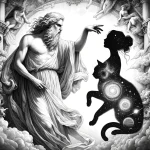
The Camel and the Arab – An Aesop’s Fable
As the sun dipped below the horizon, casting its amber glow on the dunes, an Arab camel-driver, Ahmed, completed the arduous task of loading his camel. He paused, wiped the sweat from his brow, and looked at his camel, Fatima, whose eyes seemed to reflect years of toil.
Ahmed, in a tone tinged with empathy yet filled with authority, inquired, “Fatima, we have a long journey ahead. Would you prefer to go uphill or downhill?”
Fatima glanced back at him, her eyes gleaming with a wisdom that surpassed her years. “Why do you ask, Ahmed? Is the level path through the desert now forbidden to us?”
Ahmed was taken aback by the depth of her response. For years, he had believed that he understood the desert—its harshness, its rules, and its silence. But in that moment, he realized that perhaps the desert understood him better, through the eyes of his camel.
“Fair point, Fatima,” he conceded. “Sometimes, we forget that choices are not always ours to make. Whether it’s uphill or downhill, the desert decides, and we merely abide.”
The two continued their journey, each step a testament to their collective resilience, each pause a moment of reflection on the nature of choice and destiny.
What principles and lessons can be learned from the above stories?
The tale of Ahmed and Fatima serves as a poignant reminder that the illusion of choice can sometimes be just that—an illusion. In a world where we’re often led to believe that we have control over our destinities, Fatima’s insightful question serves as a grounding reality check. It teaches us that there are forces—be it nature, circumstance, or even societal structures—that often make choices for us, whether we realize it or not.
The story also sheds light on the complexities of authority and submission. Ahmed, despite being the master, learns something valuable from Fatima. This subtle inversion of roles prompts us to reconsider the dynamics of power and wisdom, teaching us that wisdom can come from the most unexpected sources.


